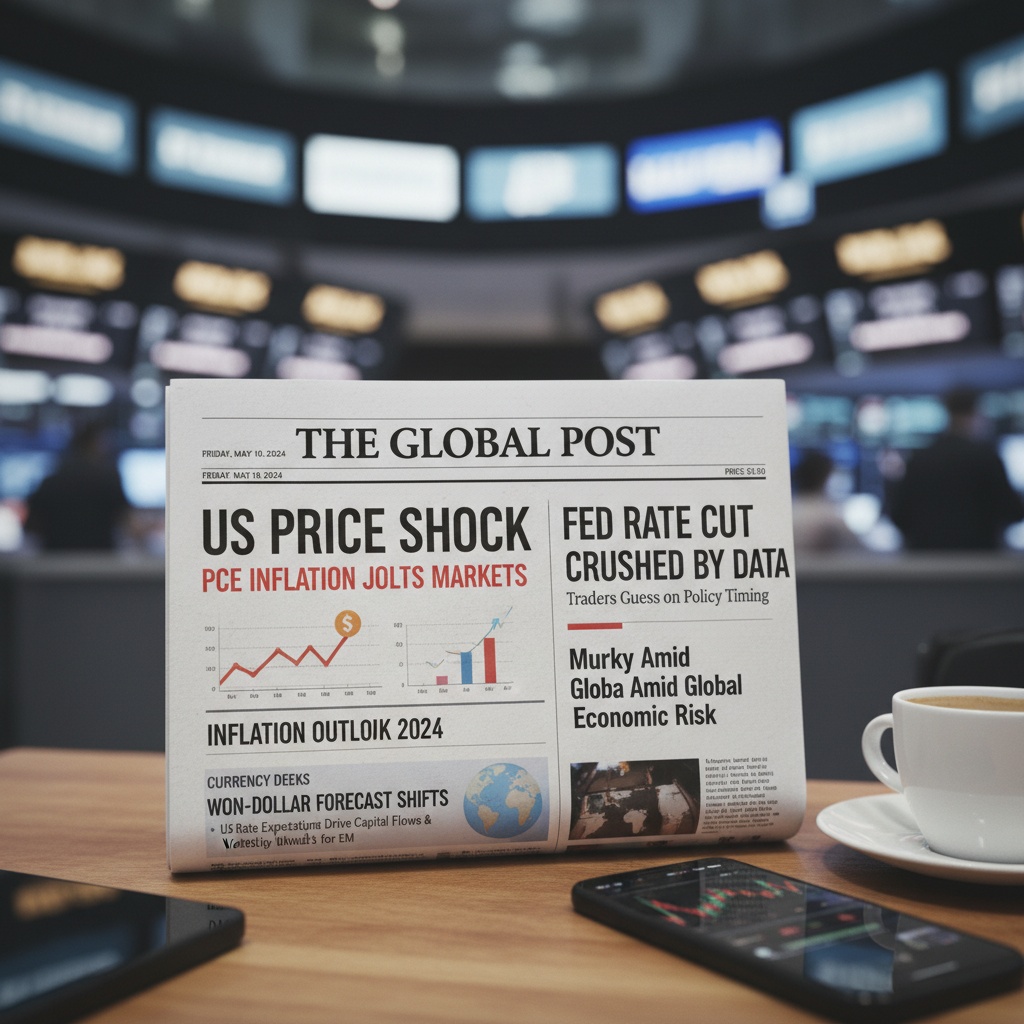● US PCE Shock Alert – Inflation Surge, Rate Cut Hopes Crushed
[LIVE Real-time Analysis] Post-US PCE Release: Key Checklist — Potential Price Shock & Scenarios of Diminishing Rate Cut Expectations, All Covered
Here are the key points we will cover in this article:
- The “True Meaning” of This PCE (August Data) — Why September Rate Cuts & Mutual Tariff Impacts Are Not Yet Reflected.
- Critical Risks Less Discussed by Other YouTubers/News — The 1-2 Month Lag Theory of PPI to CPI, and the Timing Mismatch of Tariffs & Rate Impacts.
- Specific Scenarios and Triggers for Short-term (Same Day to One Month), Mid-term (October FOMC), and Long-term (Fed Policy Shift & Global Capital Flows).
- Practical Response Points for Korea (Won, Dollar, BOK) — Won-Dollar Currency Swap, Foreign Exchange Reserves, and Constraints on Monetary Policy.
- 8 “Instant Indicators” to Check Immediately and Practical Tips for Investment & Risk Management.
We will organize this step-by-step from the perspectives of economy, interest rates, inflation, the US economy, and exchange rates, focusing on the “timing risk” and “localized amplification mechanism of external shocks” that other media outlets often overlook.
1) Right Now (Same Day) — Release Summary and Real-time Market Reaction
The PCE released this time (August data based on reporting) showed a headline figure of 2.7% and a core figure of 2.9%, which largely matched market expectations.This figure was immediately interpreted by the market as “in line with expectations → no major shock.”However, what should not be missed here is the “data lag.”Since this data is for August, the full effects of the September Fed rate cut (September FOMC) or the mutual tariffs that intensified from the end of August are not yet reflected.In other words, while it appears “stable” on the surface, actual inflationary pressures may emerge further going forward.
2) Key Points Not Discussed Elsewhere (Most Important Content)
A surge in PPI (Producer Price Index) is passed on to consumer prices with a 1-2 month lag.In this regard, if there were many items with rapidly rising PPI in July-August, their impact is highly likely to be reflected in the September-October CPI/PCE.Another point is that tariffs (especially mutual tariffs) take time to be passed on through import costs → producer prices → consumer prices.Therefore, if tariffs began to be applied in August, upward pressure on consumer prices is highly probable to become fully apparent in September-October.If this timing mismatch occurs consecutively, the “relief from data” can quickly crumble, and market expectations for rate cuts can be extinguished.Many channels talk only about “today’s release,” but the real risk comes from “next month’s data.”
3) Short-term (Today to 30 Days): Immediate Market, Rate, and Exchange Rate Checkpoints
- Key Point: Today’s data is “in line with expectations,” but signals of an “upward trend” are present.
- Instant Indicator 1: 10-year US Treasury yield (volatility/upward trend).
- Instant Indicator 2: Dollar Index (around the 100 mark, signal of returning strong dollar).
- Instant Indicator 3: Korean Won-Dollar exchange rate (if won depreciation deepens, it constrains the BOK’s options).
- Investment Practical Tip: Adjust the speed of short/long positions in the short term. Leveraged positions can be quickly impacted if indicators change simultaneously.
- Market Impact: The release itself may not cause a major shock, but if linked with PPI and tariff data, a re-evaluation within two weeks is possible.
4) Mid-term (Around the October FOMC): The Fate of Rate Cut Expectations
- Key Point: The Fed’s decision-making reflects both “current price data + future data forecasts.”
- Scenario A (Gradual Development): Even if PCE continues to rise moderately, the Fed will prioritize the point that “inflation is coming under control” and maintain its plan for a rate cut in October.
- Scenario B (Deepening Price Concerns): If the impact of tariffs and PPI is reflected in the September-October PCE/CPI, leading to heightened concerns about rising prices, the Fed will delay or scale back its rate cut schedule.
- Triggers (Key Observation Points): September-October PCE/CPI, persistence of core PCE, changes in the tone of remarks by Fed officials (including Powell).
5) Long-term (Fed Policy Shift and Global Capital Flows) — The Nature of Risky Liquidity
- Key Point: 2025-2026 is expected to be a “liquidity-driven market,” but if the conditions for liquidity (bond demand, fiscal deficits, foreign exchange demand) are not met, “risky liquidity” can emerge.
- Definition of Risky Liquidity: A structure where liquidity is supplied, but asset prices surge due to weak underlying fundamentals and can rapidly decline whenever demand dwindles.
- Why It’s a Problem: If the US pursues large-scale Treasury issuance and global demand for Treasuries (foreign buying) is weak, rising interest rates are inevitable.
- Transmission Path: Rising US interest rates → strong dollar → capital outflow from emerging markets → sharp depreciation of the Won and emerging market currencies → rapid rise in local interest rates (to defend their currencies) → global risk-off.
- Conclusion: We need to be wary not of a simple interest rate or liquidity market, but of “discord during the normalization period.”
6) Risks and Responses Specific to Korea
- Key Point: The Won-Dollar exchange rate and the Bank of Korea’s (BOK) monetary policy are influenced by the US-Korea interest rate differential, foreign exchange markets, and the possibility of a US-Korea currency swap.
- US-Korea Currency Swap (Swap Line): If established, it serves as a buffer to alleviate short-term liquidity shocks.
- Risk of No Agreement: If large-scale external fund movements (e.g., committed investment funds) are withdrawn all at once, it can be difficult to defend with foreign exchange reserves alone.
- Practical Checkpoints: Foreign investor net selling trends in bonds and stocks, changes in foreign exchange reserves, announcements of BOK intervention in the foreign exchange market.
- Policy Implications: If won depreciation persists, the BOK’s scope for rate cuts will be limited.
- Investment Tip: Hedge foreign-denominated assets, manage downside risk (depreciating won) with Won-Dollar options.
7) What to Monitor in Practice — 8 Practical Indicators
- Next month’s (October) PCE, CPI, PPI point changes (reflecting tariffs and PPI pass-through).
- Core PCE momentum (whether the upward/downward trend persists month-over-month).
- 10-year US Treasury yield trend (a signal for risk asset correction if rising).
- Dollar Index (shift between strengthening and weakening, centered around the 100 mark).
- Foreign investor net buying/selling in Korean bonds and stocks (signal of outflow/inflow shift).
- Progress in US-Korea currency swap negotiations (both official announcements and unofficial news are important).
- Changes in the tone of remarks by Fed officials (including Powell) (quick detection of a shift from “cautious” to “hawkish”).
- Global commodity and transportation costs (freight rates) (leading indicators of cost-push pressure).
8) Practical Guide for Investment & Risk Management (Field Application Tips)
- Position Management: When interest rate and exchange rate uncertainties increase, prioritize reducing leverage.
- Hedging Strategies: Prepare for downside risk in the exchange rate (won depreciation) with short-term options (put options).
- Bond Portfolio: Prioritize considering shortening duration.
- Stock Portfolio: Companies with high import dependency and consumer goods are vulnerable to tariff shocks, so adopt a selective approach.
- Short-term Profit Opportunities: When expectations for price stability are dashed, look for rebalancing opportunities in sectors related to “rate hike expectations” (financials, rate-sensitive assets).
9) Conclusion and Key Messages by Scenario
- Point 1: This PCE is “in line with expectations,” but the real test will be the September-October data.
- Point 2: Leading indicators like producer prices and tariffs have the potential to push up future consumer prices.
- Point 3: The Fed will react sensitively to future data trends, and if inflation re-accelerates, the rate-cutting stance will weaken.
- Point 4: Korea’s monetary policy maneuverability may be limited due to the exchange rate, foreign exchange reserves, and the status of US-Korea currency swaps.
- Practical Recommendation: Do not be complacent with short-term relief; monitor the reflection of September-October prices, PPI, and tariffs based on indicators.
[Related Articles…]Potential Price Shock: Summary of Market Reactions and Next Month’s Checkpoints After US PCEThe End of Rate Cuts? Fed’s Choices and Korea’s Monetary Policy Response Scenarios
*Source: [ 경제 읽어주는 남자(김광석TV) ]
– [LIVE] 미국 PCE 물가 심층분석 : 물가쇼크 오는가? 금리인하 사라지나? [즉시분석]



